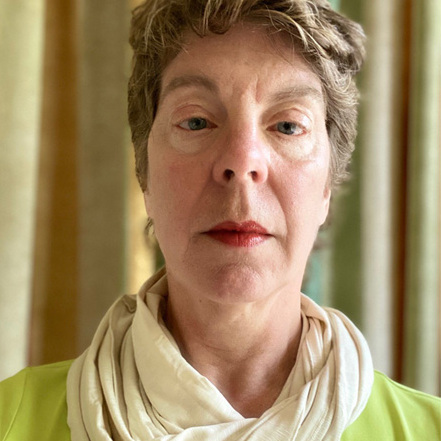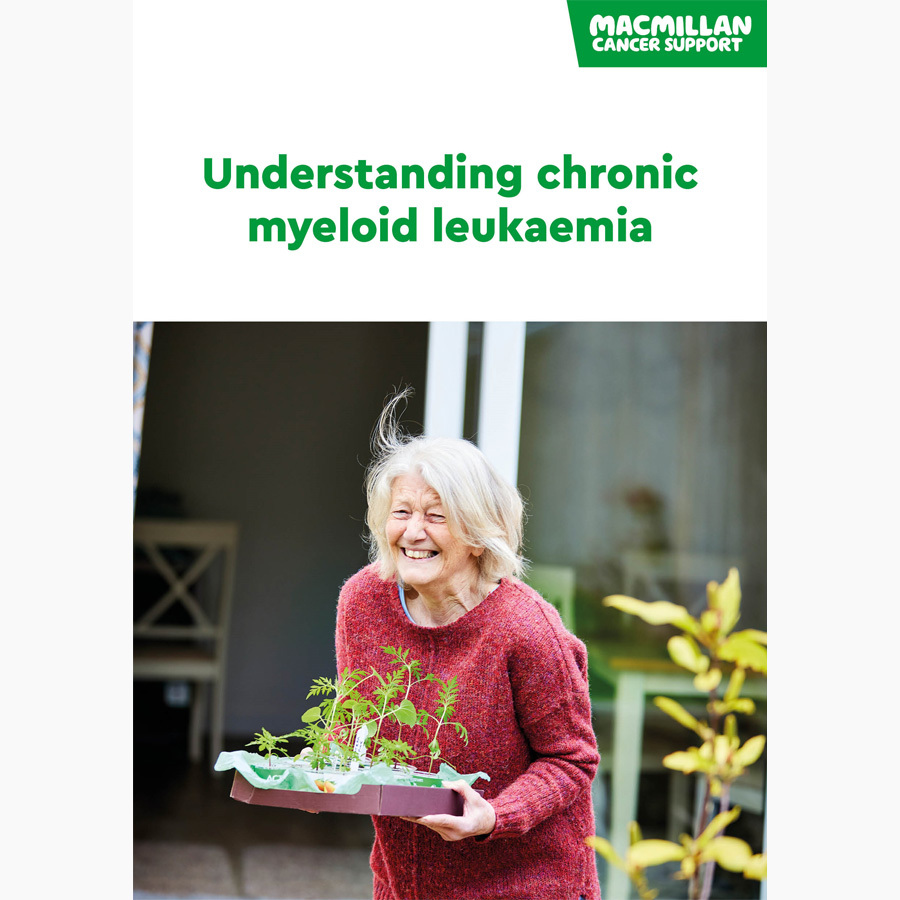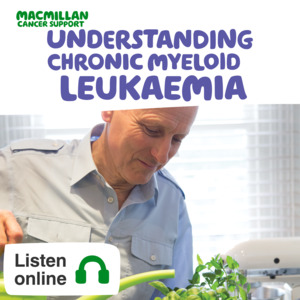Chronic myeloid leukaemia (CML)
Choose a type
On this page
-
What is chronic myeloid leukaemia (CML)?
-
Symptoms of chronic myeloid leukaemia (CML)
-
Causes of chronic myeloid leukaemia (CML)
-
Diagnosis of chronic myeloid leukaemia (CML)
-
Phases of chronic myeloid leukaemia (CML)
-
Risk score of chronic myeloid leukaemia (CML)
-
Treatment for chronic myeloid leukaemia (CML)
-
Fertility and chronic myeloid leukaemia (CML) treatment
-
Living with CML
-
How we can help
What is chronic myeloid leukaemia (CML)?
Chronic myeloid leukaemia (CML) is a cancer of the white blood cells. It starts to develop in blood stem cells in the bone marrow. It causes early white blood cells to become abnormal. CML usually develops very slowly.
About 830 people in the UK are diagnosed with CML each year. It can affect people at any age, but it is more common as people get older. For many people, it can be well-controlled and it will not shorten their life.
We have more information about other types of leukaemia.
How chronic myeloid leukaemia develops
All blood cells are made from blood stem cells. These are blood cells at the earliest stage of their development. Blood stem cells develop into the following 2 types:
- Lymphoid stem cells make white blood cells called lymphocytes.
- Myeloid stem cells make all the other types of blood cell. These include red blood cells, platelets and other white blood cells, such as neutrophils.
CML develops because of a genetic change in the stem cells. This change stops them developing into normal myeloid cells. We have more information about genes and chromosomes in chronic myeloid leukaemia (CML).
How blood cells divide
Booklets and resources
Symptoms of chronic myeloid leukaemia (CML)
Chronic myeloid leukaemia (CML) usually develops slowly. Many people do not have symptoms in the early stages. Sometimes CML is found by chance. This might be when someone has a blood test before an operation, or as part of a routine health check.
Sometimes in the early stages of CML, symptoms can be mild. They may be confused with the symptoms of more common illnesses, such as flu.
We have more information about general symptoms of leukaemia.
Causes of chronic myeloid leukaemia (CML)
Doctors do not know the exact causes of CML. But there are risk factors that can increase your chance of developing it.
-
Age
CML can develop at any age. But it is more common as people get older. Over half of people diagnosed with CML in the UK are over the age of 60.
-
Sex
CML is slightly more common in men and people assigned male at birth than women and people assigned female at birth, but we do not know why.
-
Radiation exposure
Exposure to very high radiation levels increases the risk of developing CML. For example, this might happen following a nuclear accident. Very few people in the UK will be exposed to radiation levels high enough to increase their risk of CML.
Research has found no link between the risk of developing CML and:
- living near nuclear power stations
- exposure to electro-magnetic fields
- living near high-voltage electricity cables
- household radon - this is a naturally occurring gas.
Diagnosis of chronic myeloid leukaemia (CML)
If you have symptoms, you will usually begin by seeing your GP, who will examine you. If they think you may have chronic myeloid leukaemia (CML), they will refer you to a haematologist for further tests. A haematologist is a doctor who specialises in diagnosing and treating blood problems.
The haematologist will ask you about any illnesses or health problems you have had. They will check if your spleen is enlarged and arrange tests.
Tests may include:
-
Blood tests
You will have blood tests at the hospital. These tests will:
- check the numbers of blood cells in your blood - this is called a full blood count (FBC)
- look for leukaemia cells.
If there are leukaemia cells in your blood, the haematologist will arrange more tests. These will find what type of leukaemia you have and what phase it is. This will help your doctors plan your treatment.
-
Bone marrow biopsy
A bone marrow biopsy is when a doctor or nurse takes a small sample of bone marrow to test for abnormal white blood cells. They usually take the bone marrow from the back of the hip bone (pelvis). Rarely, they may take it from the breast bone (sternum).
-
Ultrasound scan
You might have an ultrasound scan to check the size of your spleen and liver. Ultrasound scans use sound waves to build up a picture of the inside of the body. This is a painless test that takes around 10 to 15 minutes.
Cytogenetic and molecular tests
Cytogenetic and molecular tests look for gene changes (mutations) inside the leukaemia cells. Tests may include:
Waiting for test results can be a difficult time, we have more information that can help.
Related pages
Phases of chronic myeloid leukaemia (CML)
The treatment you have depends on the phase of chronic myeloid leukaemia (CML). CML usually develops slowly. The 3 phases of CML are the:
- chronic phase
- accelerated phase
- blast phase.
Doctors know the phase of CML from:
- the number of immature blood cells (blast cells) in your blood and bone marrow
- your symptoms.
Most people are diagnosed when CML is in the chronic phase.
-
Chronic phase
When CML is in the chronic phase, there may be no symptoms. Most people can live a normal life. Treatment is tablets you can take at home. You have regular blood tests to check how well the treatment is working.
For most people, the leukaemia can be well controlled for as long as treatment continues.
In the chronic phase, less than 15 in 100 blood cells in the blood or bone marrow (15%) are blast cells.
-
Accelerated phase
In a small number of people, the leukaemia may go from the chronic phase to the accelerated phase. This can happen if the CML does not respond well to treatment. Sometimes people are diagnosed with CML in the accelerated phase.
In the accelerated phase, less than 20 in 100 blood cells in the blood or bone marrow (10% to 19%) are blast cells.
In this phase, there are more blast cells in the blood or bone marrow. You may also develop some of the more common symptoms of leukaemia. If you feel unwell or develop new symptoms, tell your doctor.
-
Blast phase
For some people, CML in the accelerated phase may go into the blast phase. Rarely, people are diagnosed with CML in the blast phase. Or the leukaemia may change straight from the chronic phase to the blast phase.
The blast phase is like an acute leukaemia. In this phase, more than 20 in 100 blood cells in the blood or bone marrow (20%) are blast cells. The blast phase is sometimes called blast crisis.
You will likely develop symptoms because the bone marrow is not making enough healthy blood cells. We have more information about symptoms of CML.
-
Relapse
Relapse means the leukaemia cells have come back after a time in remission (where there are no signs of leukaemia cells). In CML, this is usually found using the PCR test.
Risk score of chronic myeloid leukaemia (CML)
As well as the phase of CML, your cancer doctor will calculate your risk score. This can help them to plan the best treatment for you.
Risk scores are based on:
- your age
- the size of your spleen
- the number of blast cells in your blood
- your platelet count.
Depending on the risk score, people with CML can be grouped into 3 risk groups:
- low
- intermediate
- high.
Knowing the risk group can give your haematologist an idea of how likely the CML is to respond well to treatment.
Most people with CML respond to tyrosine kinase inhibitor drugs (TKIs) regardless of their risk score.
Treatment for chronic myeloid leukaemia (CML)
A team of specialists will meet to discuss the best possible treatment for you. This is called a multidisciplinary team (MDT).
Your haematologist or specialist nurse will explain the different treatments and their side effects. They will also talk to you about things to consider when making treatment decisions. You will need this information before you give your permission (consent) to have any treatment.
The aim of treatment is to put CML into remission and keep it in remission. This means there are no signs of CML in your PCR blood test, and you feel well. There are different levels of remission.
Treatments may include:
-
Tyrosine Kinase Inhibitors (TKIs)
The main treatment for CML is with drugs called tyrosine kinase inhibitors (TKIs).
-
Chemotherapy
Chemotherapy uses anti-cancer (cytotoxic) drugs to destroy or damage leukaemia cells. It works by disrupting the way leukaemia cells grow and divide.
-
Stem cell transplant
Your doctors may suggest a stem cell transplant (sometimes called a bone marrow transplant). A stem cell transplant is an intensive treatment that is not suitable for everyone. It is not often used to treat CML.
-
Interferon alpha
If other treatments have not worked, some people may be given interferon alpha in the chronic phase of CML. Doctors may also use interferon alpha for people who need CML treatment and are planning to get pregnant, or are already pregnant.
-
Leukapheresis
You might have a very high number of white blood cells in your blood when you are diagnosed with CML. Doctors can treat this using a process called leukapheresis.
You may have some treatments as part of a clinical trial.
We have more information about treatment for CML.
Fertility and chronic myeloid leukaemia (CML) treatment
Some CML treatments may affect your fertility or harm a developing baby. Because of this you may be advised to use contraception to prevent a pregnancy. If you are worried about your fertility, it is important to talk with your doctor before you start treatment.
Living with CML
Follow-up and monitoring CML
If you have treatment with a tyrosine kinase inhibitor (TKI), you will be monitored by your healthcare team every 1 to 2 weeks.
Your doctor will do a polymerase chain reaction (PCR) blood test to check for leukaemia cells every 3 months to start with. If you have a good response to TKI treatment, this may be done less often.
Sometimes they may take a bone marrow sample. Your doctor can tell you how often you might need this.
As time goes on, you may only need a check-up every 3 to 6 months.
If you have another type of treatment, your doctor or nurse will tell you how often you will have appointments. If you have any problems or notice new symptoms between appointments, tell your doctor or specialist nurse.
Well-being and recovery
Most people with chronic myeloid leukaemia (CML) have a normal life expectancy. To help you stay as well as possible, you may want to make changes to your lifestyle. Even if you had a healthy lifestyle before your diagnosis, you may want to make the most of your health.
A healthy lifestyle can help speed up your recovery. Even small lifestyle changes may improve your well-being and long-term health.
Even if you already have a healthy lifestyle, you may choose to make some positive changes after treatment. We have more information on leading a healthy lifestyle after treatment.Getting support
Everyone has their own way of dealing with illness and the different emotions they experience. You may find it helpful to talk things over with family and friends or your doctor or nurse.
Macmillan is also here to support you. If you would like to talk, you can:
- Call the Macmillan Support Line for free on 0808 808 00 00.
- Chat to our specialists online.
- Visit our chronic myeloid leukaemia (CML) forum to talk with people who have been affected by chronic myeloid leukaemia (CML), share your experience, and ask an expert your questions.
Other organisations who offer information and support
-
CML Support
CML Support provide information and support to patients, their families and carers whose lives have been affected by CML.
-
Anthony Nolan
Anthony Nolan is the UK’s largest stem cell and bone marrow register.
-
Leukaemia CARE
Leukaemia CARE provides care and support to patients, their families and carers whose lives have been affected by leukaemia, lymphoma or a related blood disorder.
-
Blood Cancer UK
Blood Cancer UK is a blood cancer research charity that provides information and support on any type of blood cancer.
About our information
This information has been written, revised and edited by Macmillan Cancer Support’s Cancer Information Development team. It has been reviewed by expert medical and health professionals and people living with cancer.
-
References
Below is a sample of the sources used in our chronic myeloid leukaemia (CML) information. If you would like more information about the sources we use, please contact us at
informationproductionteam@macmillan.org.uk
National Institute for Health and Care Excellence (NICE). Asciminib for treating chronic myeloid leukaemia after 2 or more tyrosine kinase inhibitors (Published 03 August 2022). Available from: www.nice.org.uk/guidance/ta813 (accessed July 2023).
Smith, G, Apperley, J et al. A British Society for Haematology Guideline on the diagnosis and management of chronic myeloid leukaemia. British Journal of Haematology. 2022. Volume 191. Pages 171-193. Available from: onlinelibrary.wiley.com/doi/10.1111/bjh.16971 (accessed July 2023)
Smith, G, Apperley, J et al. A British Society for Haematology Guideline on the diagnosis and management of chronic myeloid leukaemia. British Journal of Haematology. 2022. Volume 191. Pages 171-193. Available from: onlinelibrary.wiley.com/doi/10.1111/bjh.16971 (accessed July 2023)

Reviewer
Consultant Haematologist and Honorary Clinical Senior Lecturer
Queen Elizabeth University Hospital, Greater Glasgow and Clyde
Date reviewed

Our cancer information meets the PIF TICK quality mark.
This means it is easy to use, up-to-date and based on the latest evidence. Learn more about how we produce our information.
The language we use
We want everyone affected by cancer to feel our information is written for them.
We want our information to be as clear as possible. To do this, we try to:
- use plain English
- explain medical words
- use short sentences
- use illustrations to explain text
- structure the information clearly
- make sure important points are clear.
We use gender-inclusive language and talk to our readers as ‘you’ so that everyone feels included. Where clinically necessary we use the terms ‘men’ and ‘women’ or ‘male’ and ‘female’. For example, we do so when talking about parts of the body or mentioning statistics or research about who is affected.
You can read more about how we produce our information here.






